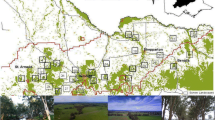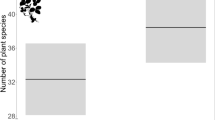Abstract
In this paper the vegetation of 20 green lanes, defined as tracks bounded by hedgerows, is examined in terms of composition and structure and compared with that of 20 matched single hedgerows. For analysis the vegetation of the lanes was separated into three areas; central track, verges inside of hedgerows and verges outside of hedgerows. The vegetation of these areas was found to differ in species richness, community structure, plant strategies and environmental traits. When compared with verges of the matched single hedgerows, the inside verges and central track were greatly different whereas the outside verge appeared broadly similar. Green lanes contained significantly more plant species than matched single hedgerows, differences being most pronounced when compared as landscape units, rather than as a mean of the constituent parts. The potential effect of surrounding land use on green lane floral diversity is discussed as well as the importance of maintaining the structural diversity of green lanes for farmland biodiversity.
Similar content being viewed by others
References
Aude E., Tybirk K. and Bruus Pederson M. (2003). Vegetation diversity of conventional and organic hedgerows in Denmark. Agriculture, Ecosystems and Environment 99: 135–147
Barr C.J., Britt C.P., Sparks T.H. 1995. Hedgerow Management and Wildlife: A Review of Research on the Effects of Hedgerow Management and Adjacent Land on Biodiversity. ITE/ADAS
Barr C.J., Bunce R.G.H., Clarke R.T., Fuller R.M., Furse M.T., Gillespie M.K., Groom G.B., Hallam C.J., Hornung M., Howard D.C. and Ness M.J. 1993. Countryside Survey 1990. Department of the Environment, Main Report.
Benton T.G., Bryant D.M., Cole L. and Crick H.Q.P. (2002). Linking agricultural practice to insect and bird populations: a historical study over three decades. Journal of Applied Ecology 39: 673–687
Boutin C. and Jobin B. (1998). Intensity of agricultural practices and effects on adjacent habitats. Ecological Applications 8: 544–557
Carey P.D., Barnett C.L., Greenslade P.D., Hulmes S., Garbutt R.A., Warman E.A., Myhill D., Scott R.J., Smart S.M., Manchester H.J., Robinson J., Walker K.J., Howard D.C. and Firbank L.G. (2002). A comparison of the ecological quality of land between an English agri-environment scheme and the countryside as a whole. Biological Conservation 108: 183–197
Croxton P.J., Carvell C., Mountford J.O. and Sparks T.H. (2002). A comparison of green lanes and field margins as bumblebee habitat in an arable landscape. Biological Conservation 107: 365–374
Croxton P.J., Hann J.P., Greatorex-Davies J.N. and Sparks T.H. (2005). Linear hotspots? The floral diversity of green lanes. Biological Conservation 121: 579–584
Dover J.W., Sparks T.H. and Greatorex-Davies J.N. (1997). The importance of shelter for butterflies in open landscapes. Journal of Insect Conservation 1: 89–97
Dover J.W., Sparks T., Clarke S., Gobbett K. and Glossop S. (2000). Linear features and butterflies: the importance of green lanes. Agriculture, Ecosystems and Environment 80: 227–242
Dover J. and Sparks T. (2000). A review of the ecology of butterflies in British hedgerows. Journal of Environmental Management 60: 51–63
Dover J.W. and Sparks T.H. (2001). Green lanes: biodiversity reservoirs in farmland?. In: Barr, C.J. and Petit, S. (eds) Hedgerows of the World: Their Ecological Functions in different landscapes, pp 241–250. IALE (UK), Lymm
Grime J.P., Hodgson J.G. and Hunt R. (1988). Comparative Plant Ecology: A Functional Approach to Common British Species. Unwin Hyman, London
Haines-Young R.H., Barr C.J., Black H.I.J., Briggs D.J., Bunce R.G.H., Clarke R.T., Cooper A., Dawson F.H., Firbank L.G., Fuller R.M., Furse M.T., Gillespie M.K., Hill R., Hornung M., Howard D.C., McCann T., Morecroft M.D., Petit S., Sier A.R.J., Smart S.M., Smith G.M., Stott A.P., Stuart R.C. and Watkins J.W. (2000). Accounting for Nature: Assessing Habitats in the UK Countryside. DETR, London
Hill M.O., Mountford J.O., Roy D.B. and Bunce R.G.H. (1999). Ellenberg's Indicator Values for British Plants. HMSO, Norwich
Hinsley S.A. and Bellamy P.E. (2000). The influence of hedge structuremanagement and landscape context on the value of hedgerows to birds: a review. Journal of Environmental Management 60: 33–49
Kleijn D. and Snoeijing G.I.J. (1997). Field boundary vegetation and the effects of agrochemical drift: Botanical change caused by low levels of herbicide and fertilizer. Journal of Applied Ecology 34: 1413–1425
Maudsley M. (2000). A review of the ecology and conservation of hedgerow invertebrates in Britain. Journal of Environmental Management 60: 65–76
McCollin D., Jackson J.I., Bunce R.G.H., Barr C.J. and Stuart R. (2000). Hedgerows as habitat for woodland plants. Journal of Environmental Management 60: 77–90
Moonen A.C. and Marshall E.J.P. (2001). The influence of sown margin strips, management and boundary structure on herbaceous field margin vegetation in two neighbouring farms in southern England. Agriculture Ecosystems and Environment 86: 187–202
Parish T., Lakhani K.H. and Sparks T.H. (1994). Modelling the relationship between bird population variables and hedgerow and other field margin attributes. I. Species richness of wintersummer and breeding birds. Journal of Applied Ecology 31: 764–775
Siegel S. and Castellan N.J. (1988). Non-parametric Statistics for the Behavioural Sciences. McGraw-Hill, New York
Sparks T.H., Parish T. and Hinsley S.A. (1996). Breeding birds in field boundaries in an agricultural landscape. Agriculture, Ecosystems and Environment 60: 1–8
Stoate C. (1996). The changing face of lowland farming and wildlife Part 2 1945–1995. British Wildlife 7: 162–172
Tsiouris S. and Marshall E.P.J. (1998). Observations on patterns of granular fertiliser deposition beside hedges and its likely effects on the botanical composition of field margins. Annals of Applied Biology 132: 115–127
Author information
Authors and Affiliations
Corresponding author
Rights and permissions
About this article
Cite this article
Walker, M.P., Dover, J.W., Sparks, T.H. et al. Hedges and Green Lanes: Vegetation Composition and Structure. Biodivers Conserv 15, 2595–2610 (2006). https://doi.org/10.1007/s10531-005-4879-x
Received:
Accepted:
Published:
Issue Date:
DOI: https://doi.org/10.1007/s10531-005-4879-x




